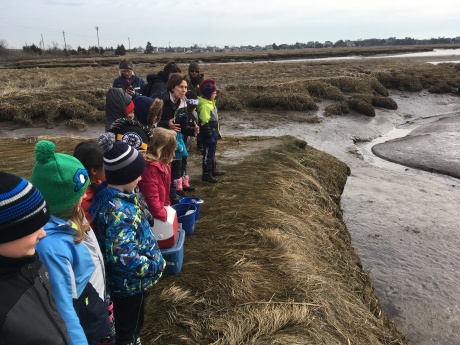
Students overlook the Parker River Wildlife Refuge salt marsh at low tide.
To support second grade’s life science curriculum transition to habitats this spring, the Science Center coordinated field trips with the Mass Audubon Society for all of our grade two classrooms to the Joppa Flats Education Center on Plum Island. These programs are facilitated by a mix of Mass Audubon educators and volunteers who are passionate about introducing our youth to the often overlooked, but invaluable Parker River Wildlife Refuge, and estuary at the mouth of the Parker and Merrimack River home to a diverse and abundant amount of wildlife.
Students started on the salt marshes of the Parker River, investigating the organisms that make their home in the habitats thick sea hay and the role the ebb and flow of the tides play in bringing life to and from the ocean and the marsh. They slopped through porous ground and vegetation, hunting for “coffee bean snails” and other creatures that make their home in the detritus layers of the marsh as its native ducks would.
A short bus ride away, students clambered over sand dunes that had overcome the boardwalk during the March storms on their way to the beach. They mimicked the behavior of piping plovers making nests on the island’s beach and dunes while learning about how their nesting grounds are protected by the reserve during their nesting season. Students caught a glimpse of the reconstruction efforts of the sea walls along the islands more developed area before learning about how the sand dunes interlocking roots create natural barriers for the salt marsh and land further inland.
All the while students braved the elements, with stronger winds and cooler temperatures than those found in Burlington. Our students were very engaged and we look forward to making connecting between these habitats and those they will explore closer to home later in May when they investigate the many habitats found at the Mill Pond Reservoir.

No comments:
Post a Comment